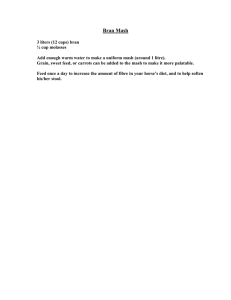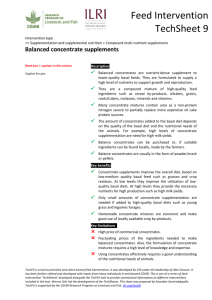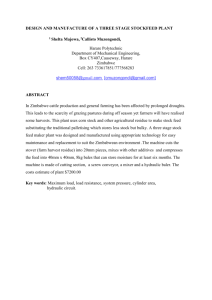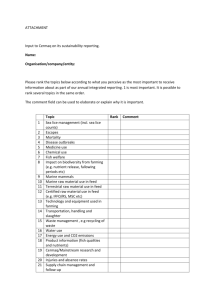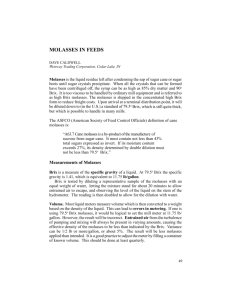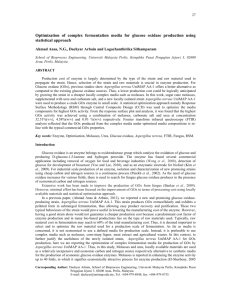Techsheet10 - UMMB
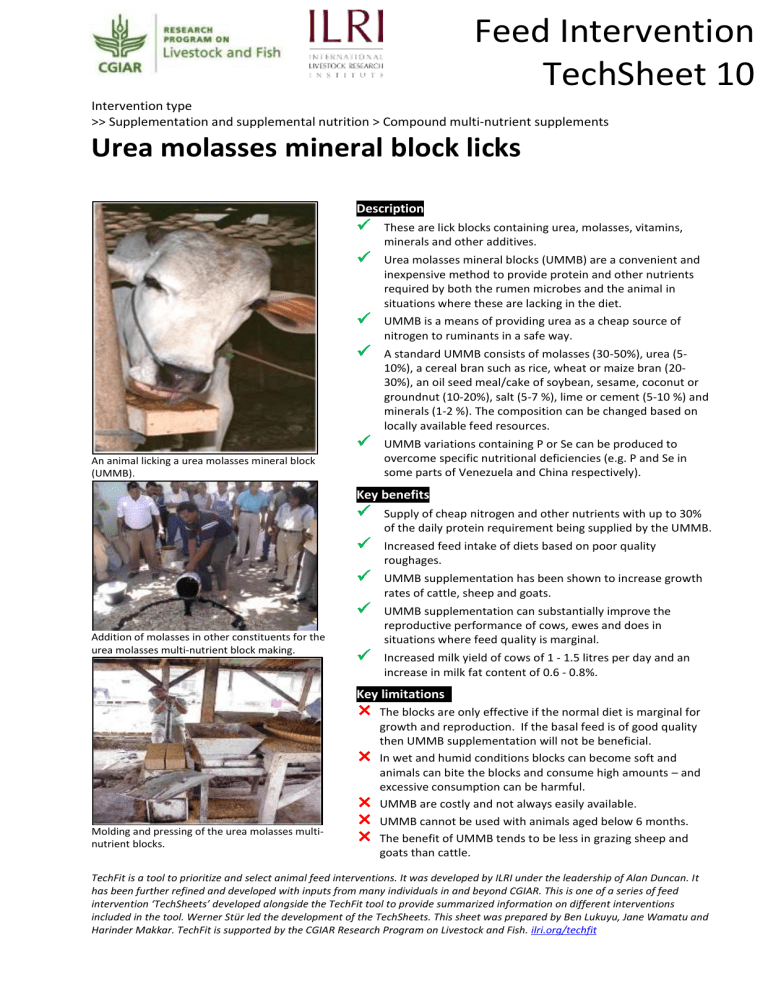
Feed Intervention
TechSheet 10
Intervention type
>> Supplementation and supplemental nutrition > Compound multi-nutrient supplements
Urea molasses mineral block licks
An animal licking a urea molasses mineral block
(UMMB).
Addition of molasses in other constituents for the urea molasses multi-nutrient block making.
Molding and pressing of the urea molasses multinutrient blocks.
Description
These are lick blocks containing urea, molasses, vitamins, minerals and other additives.
Urea molasses mineral blocks (UMMB) are a convenient and inexpensive method to provide protein and other nutrients required by both the rumen microbes and the animal in situations where these are lacking in the diet.
UMMB is a means of providing urea as a cheap source of nitrogen to ruminants in a safe way.
A standard UMMB consists of molasses (30-50%), urea (5-
10%), a cereal bran such as rice, wheat or maize bran (20-
30%), an oil seed meal/cake of soybean, sesame, coconut or groundnut (10-20%), salt (5-7 %), lime or cement (5-10 %) and minerals (1-2 %). The composition can be changed based on locally available feed resources.
UMMB variations containing P or Se can be produced to overcome specific nutritional deficiencies (e.g. P and Se in some parts of Venezuela and China respectively).
Key benefits
Supply of cheap nitrogen and other nutrients with up to 30% of the daily protein requirement being supplied by the UMMB.
Increased feed intake of diets based on poor quality roughages.
UMMB supplementation has been shown to increase growth rates of cattle, sheep and goats.
UMMB supplementation can substantially improve the reproductive performance of cows, ewes and does in situations where feed quality is marginal.
Increased milk yield of cows of 1 - 1.5 litres per day and an increase in milk fat content of 0.6 - 0.8%.
Key limitations
1
The blocks are only effective if the normal diet is marginal for growth and reproduction. If the basal feed is of good quality then UMMB supplementation will not be beneficial.
In wet and humid conditions blocks can become soft and animals can bite the blocks and consume high amounts – and excessive consumption can be harmful.
UMMB are costly and not always easily available.
UMMB cannot be used with animals aged below 6 months.
The benefit of UMMB tends to be less in grazing sheep and goats than cattle.
TechFit is a tool to prioritize and select animal feed interventions. It was developed by ILRI under the leadership of Alan Duncan. It has been further refined and developed with inputs from many individuals in and beyond CGIAR. This is one of a series of feed intervention ‘TechSheets’ developed alongside the TechFit tool to provide summarized information on different interventions included in the tool. Werner Stür led the development of the TechSheets. This sheet was prepared by Ben Lukuyu, Jane Wamatu and
Harinder Makkar. TechFit is supported by the CGIAR Research Program on Livestock and Fish. ilri.org/techfit
Where does this intervention fit?
Potential to overcome feed limitations
Feed scarcity during dry season :
Feed scarcity during cropping season :
Low feed availability :
Poor feed quality
Score very high low low high
Applicability to livestock
Cattle/buffalo
Score
Breeding (cow-calf) : medium
Fattening : high
Sheep/goats
Pigs
Dairy :
Breeding :
Fattening :
Breeding (sowpiglets) :
Fattening : high medium high n/a* n/a
Applicability to farming system
Pastoral (extensive grazing systems) :
Agro-pastoral/extensive mixed systems :
Intensive mixed crop-livestock system :
Landless livestock producers :
Score very high very high high very high
Requirement for resources
Requirement for
Land :
Score none
Water :
Labour :
Cash/credit :
Access to inputs : none low high very high
Knowledge/skills : high
* n/a = not applicable
For more information:
Jayasuriya, M.C.N. and Smith, T. (1999) IAEA working document on Guidelines for developing feed supplementation packages, Vienna, Austria.
Urea molasses mineral block (UMMB): ftp://ftp.fao.org/docrep/fao/010/a0242e/a0242e00.pdf
and http://www-naweb.iaea.org/nafa/aph/faq-ummb.pdf
How to make UMMB: http://www.esgpip.org/PDF/Technical%20bulletin%20No.1.pdf
This document is licensed for use under a Creative Commons Attribution-Noncommercial-Share Alike 3.0 Unported License. June 2015
This document is licensed for use under a Creative Commons Attribution-Noncommercial-Share Alike 3.0 Unported License. June 2015
